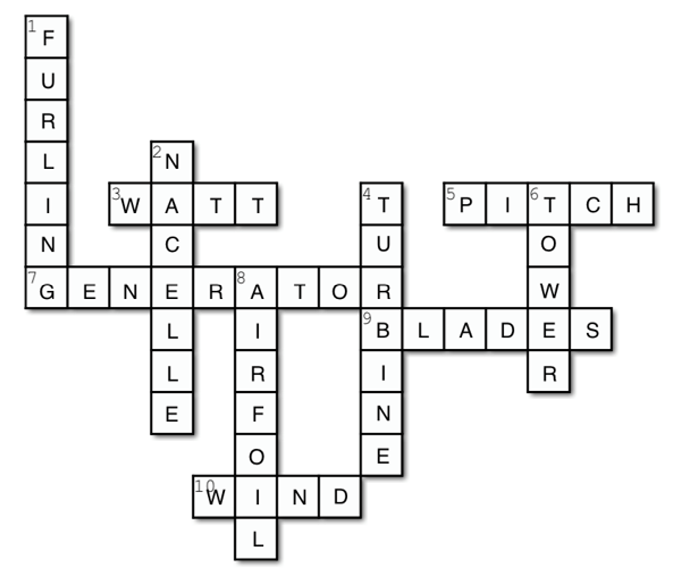👋 Welcome
Welcome to the Wind Learning Adventure! Click "Next" to begin your journey.
🌀 Welcome to the World of Wind Power!
Imagine capturing the power of the wind to generate electricity. That’s exactly what wind energy does.
Wind energy is a clean, renewable source that uses turbines to convert air movement into electricity.
This workbook introduces you to the fascinating world of wind energy – how it works, why it matters,
and how it can help transform our energy future.
🌍 Why Learn About Wind Energy?
As we face the challenges of climate change and limited fossil fuels, wind power offers a smart,
eco-friendly solution to reduce our carbon footprint and move toward a cleaner, more sustainable world.
📚 What You’ll Learn
-
- The Basics of Wind Energy: How wind is turned into electricity
- Wind Speed & Location: Why geography matters
- Measuring the Wind: Explore how we collect wind data
- Airfoils & Blade Design: Build and test blade shapes to learn what works best
- Build a Wind Turbine: Build, test and measure output in a hands-on project
🔍 How It Works
This workbook blends explanation with action. Through hands-on tasks and clear examples,
you’ll engage with real wind technology and build understanding step-by-step.
🌬️ Get Ready to Soar!
By the end of this workbook, you’ll have a strong understanding of how wind energy works
and the knowledge to explore real-world energy solutions hands-on.
Let’s harness the power of the wind!
💨 Why is Wind Energy Important?
Now, let’s dive into wind power!
Wind energy captures the movement of air and transforms it into electricity using wind turbines. It’s an exciting technology that blends science with sustainability—impacting how we live and care for our environment.
✅ Key Advantages of Wind Energy
- Renewable Energy Source: Wind is naturally replenished and available almost anywhere, day or night.
- Environmentally Friendly: Wind turbines generate electricity without producing harmful emissions.
- Low Operating Costs: Once installed, wind turbines are efficient and inexpensive to maintain.
- Energy Independence: Communities can produce their own power using local wind resources.
- Versatile Applications: Wind energy powers everything from homes and schools to farms and large wind farms.
🇬🇭 Why is Wind Energy Important in Ghana?
Ghana has strong, steady coastal winds that make it ideal for wind power. As the country’s energy needs grow,
wind offers a clean and sustainable solution to reduce fossil fuel use and provide reliable electricity—especially in remote or coastal areas.
Wind power can support Ghana’s development goals, help protect the environment, and strengthen energy security across the country.
🚀 What’s Next?
In the next chapters, you’ll explore how wind energy works, discover how blade design and wind speed affect power, and even build your own turbine models!
Let’s begin your journey into wind power!
📘 Key Wind Energy Terms
Use this glossary to understand important concepts and terms used throughout your wind energy lessons.
🧰 Additional Materials for Experiments
These simple tools and materials will help you bring wind energy to life through hands-on experiments.
- Scissors: To cut out the wind rose
- Paper Cup: To serve as a base for the wind rose
- Tape: To secure components
- Straw: Acts as a tower for the wind rose
- Stopwatch: To measure rotation time
- Colorful Marker: To decorate and mark sections
- 30cm Light Thread: Used to suspend the paper clip
- Fan: Creates wind to turn the wind rose
- Paper Clip: Acts as a weight
- Narrow Wooden Stick: Holds the airfoil
- 2 Rectangular Papers (A5): Used to build the airfoil
- Hairdryer: Simulates wind for tests
- Multimeter: Measures the performance of your wind turbine
The kit includes most of what you’ll need—just gather a few extras and get ready to explore!
🔌 Using a Multimeter
A multimeter is a powerful tool that helps you measure voltage, current, and resistance in circuits.
Here’s how to get started:
📸 Parts of a Multimeter
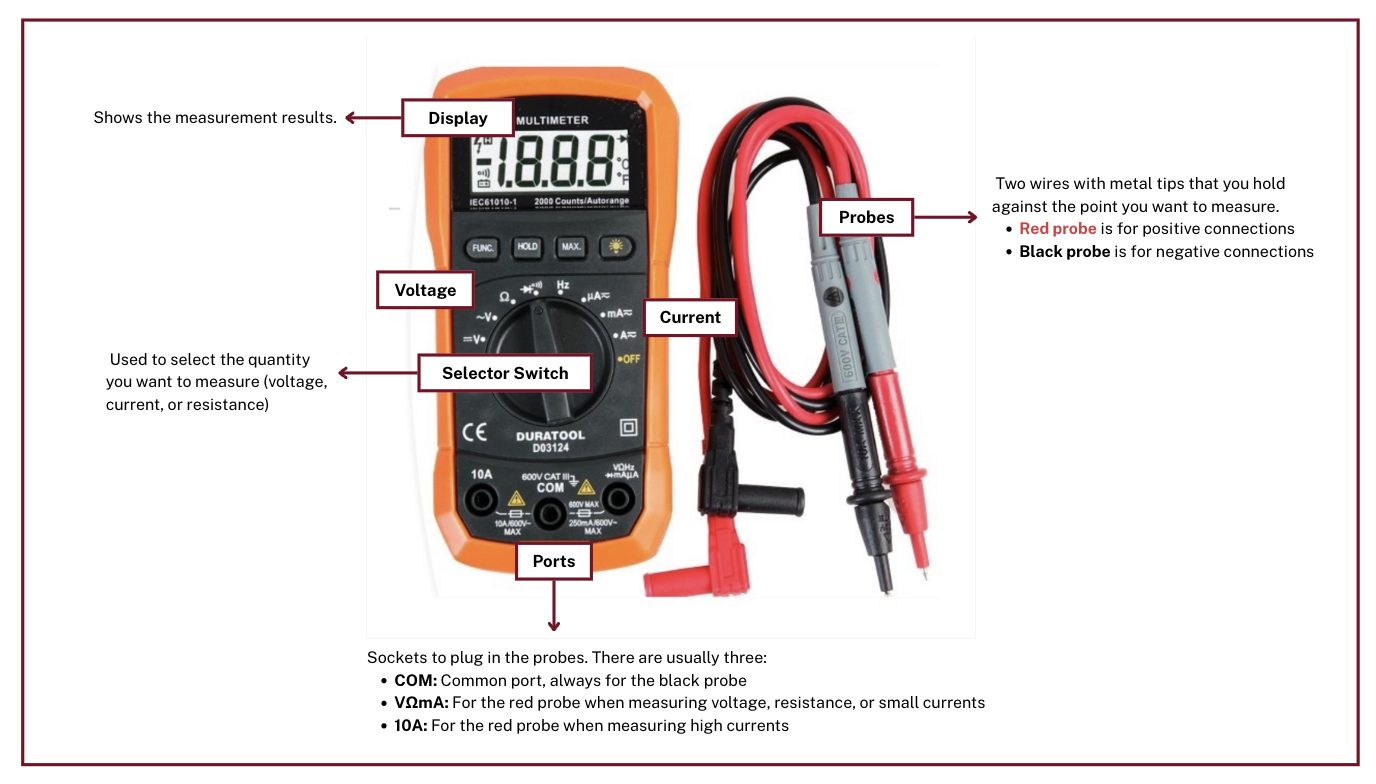
🛠️ Steps to Use a Multimeter
- Turn on the Multimeter: Use the dial to switch it on.
- Select the Measurement Type:
- Voltage (V): To measure voltage, turn the dial to “V” with a straight line (for DC voltage) or a wavy line (for AC voltage).
- Current (A): To measure current, turn the dial to “A” with the corresponding symbol. Choose between “mA” (milliamps) and “A” (amps) depending on the expected current. we usually just use mA!
- Resistance (Ω): To measure resistance, turn the dial to the “Ω” symbol.
- Set the Range: Start with the highest setting to avoid damage.
- Connect the Probes:
- Plug black probe into COM port.
- Plug red probe into the appropriate port:
- For voltage and resistance measurements, use “VΩmA”.
- For current measurements, use “VΩmA” or “10A” depending on the current.
- Take the Measurement:
- Voltage: Hold the metal tips of the probes against the two points where you want to measure the voltage. Make sure to observe the correct polarity (positive and negative).
- Current: Insert the multimeter into the circuit by breaking the circuit and connecting the multimeter in between so that the current flows through the multimeter.
- Resistance: Hold the metal tips of the probes against the two ends of the component or connection where you want to measure resistance.
- Read the Result: Look at the screen and note the value and unit (V, A, mA, Ω).
- Turn Off the Multimeter: Rotate the dial to OFF.
⚠️ Safety First!
- Never measure voltage when set to current or resistance!
- Start with the highest range setting for safety.
- “Hands off!” Avoid touching probe tips directly—this ensures accuracy and protects you from shock.
Now you’re ready to use your multimeter safely and effectively—happy measuring! ⚡
Chapter 1 – Wind Basics
In this chapter, we will find out about the following basics:
- Energy in general
- Renewable and Non-Renewable Energy Sources
- Characteristics of wind
- Wind energy
- Windy places
- How to use the wind atlas
- Different stakeholder positions regarding the implementation of wind energy
🎯 Learning Objective
- Understand the basics of wind energy: Gain a comprehensive understanding of energy in general and how wind energy is harnessed, including the principles of wind power generation using turbines.
- Know the differences of renewable and non-renewable energy sources: Be able to allocate different energy sources correctly.
- Explore key factors affecting wind speed and power: Learn about factors such as wind speed, altitude, location and environmental conditions that influence wind energy production.
- Analyze different wind energy sources: Evaluate the differences between high places, open spaces, coastal regions and offshore areas in terms of wind energy potential.
- Understand the mechanism of wind: Gain insight into the dynamics of sea breeze vs. land breeze and how these mechanisms affect wind power.
- Explore offshore wind energy: Learn about offshore wind turbines and their advantages in capturing stronger, more consistent winds.
- Understand the concept of the wind atlas: Get to know the wind atlas and why it can be a valuable tool to assess the quality of a region.
- Assess and apply wind energy in real-world contexts: Develop an understanding of how different stakeholders see the topic of wind energy and how to come up with a solution that incorporates all viewpoints.
1.1 Wind, energy & wind energy introduction
In this chapter you will play some games to learn about the basics of wind, energy and wind energy!
Exercise:
Task 1 – Energy name game
- Form 2 groups from the class.
- Form a sitting circle and choose a group leader to explain the procedure.
- Now the game begins: Someone starts with the first letter of their family name and relates it to a term, which is energy-related — a source of energy, an energy-consuming or -producing device, or energy term.
- Look at the examples:
- M: Microwave
- G: Generator
- B: Biomass
- Now go around the circle; everyone takes their turn. The last letter of the last word is always the first letter of a new energy word.
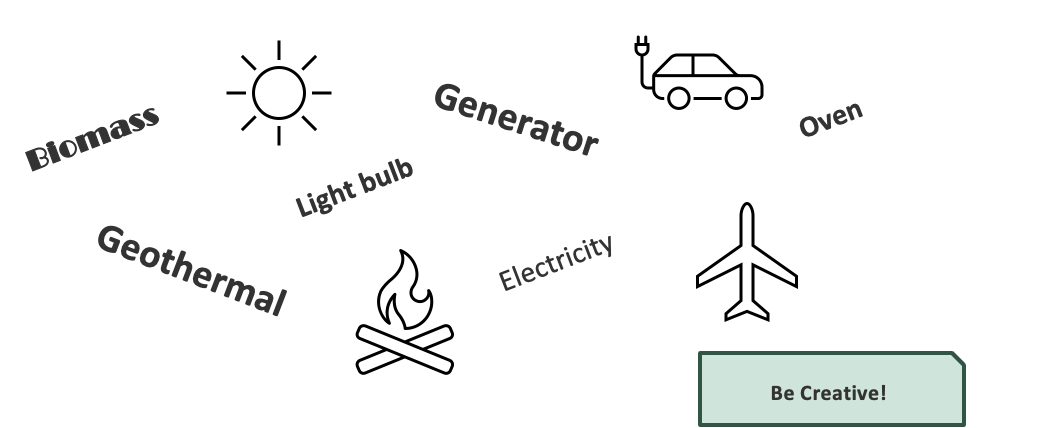
✅ Good to know about energy: Energy is what makes things happen—it’s the power to do work. For example, when you eat food, your body turns that energy into movement, like running or playing.
Energy comes in two main types:
- Kinetic energy: Energy of moving things (like a bike going down a hill).
- Potential energy: Stored energy (like a ball sitting on a high shelf).
There are also other kinds of energy, like:
- Heat energy (from fire or sun)
- Electric energy (in plugs and batteries)
- Gravitational potential energy (energy from height, like water in a dam)
Task 2 – Renewable and non-renewable energy sources
- Form a group of 2–4 students.
- Look at the following pictures and decide which of them are renewable energy sources and which are non-renewable / conservative energy sources!
- Think about: do you know how they all are named?
- Try it on your own first and then discuss it in the group.
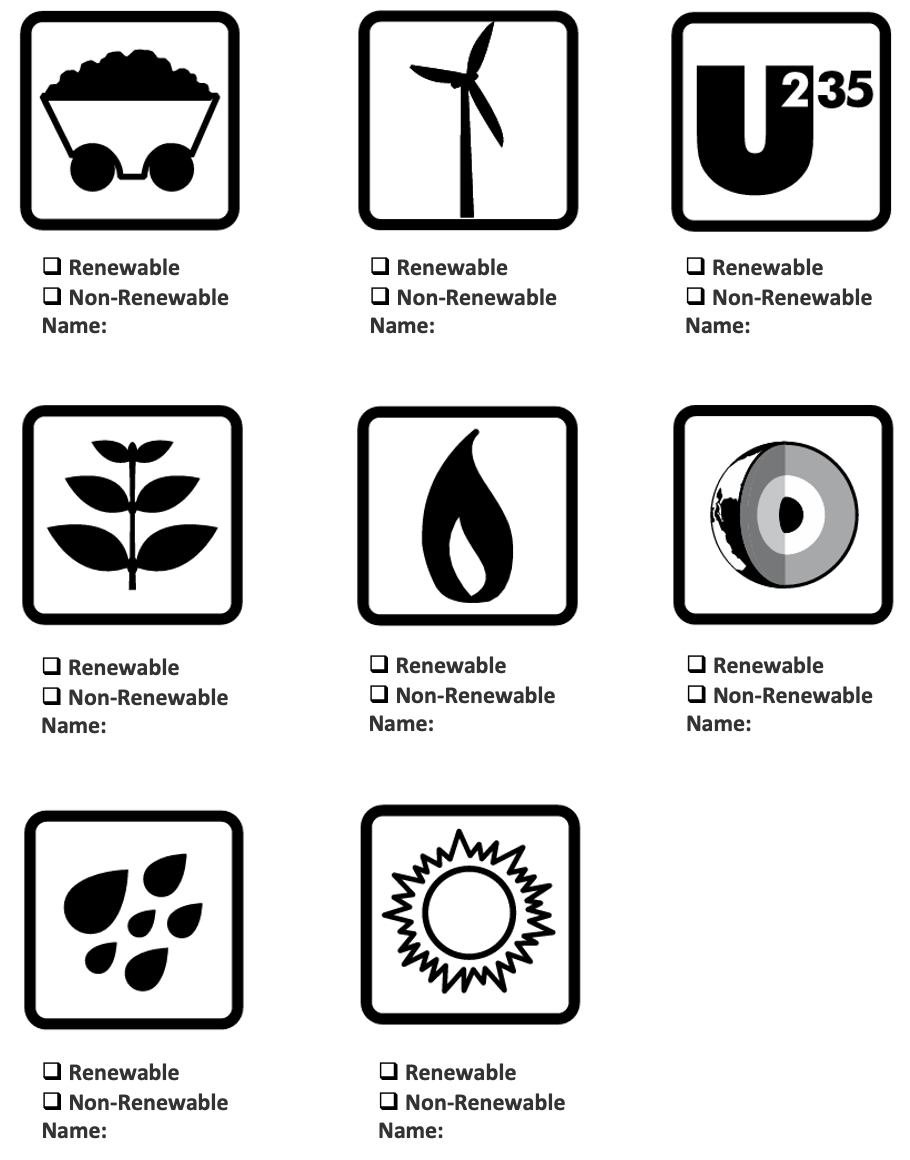
✅ Good to know about wind and wind energy:
- Wind energy is a renewable energy source.
- Wind energy comes from moving air.
- Basically, wind is caused by 3 things:
- The heating of the atmosphere by the sun
- The rotation of the Earth
- The Earth’s surface irregularities
- Some areas have strong winds, while others have very little.
- Wind energy can’t produce electricity all the time—it depends on the wind.
- It doesn’t pollute the air but can create noise.
1.2 Windy Places
In this chapter you will learn more about the basics of wind energy and where you can find windier locations.
📝 Exercise: Task 1
Allocate these places according to their wind strength. Good wind locations for the production of energy are (very) windy, bad wind locations have hardly any wind.
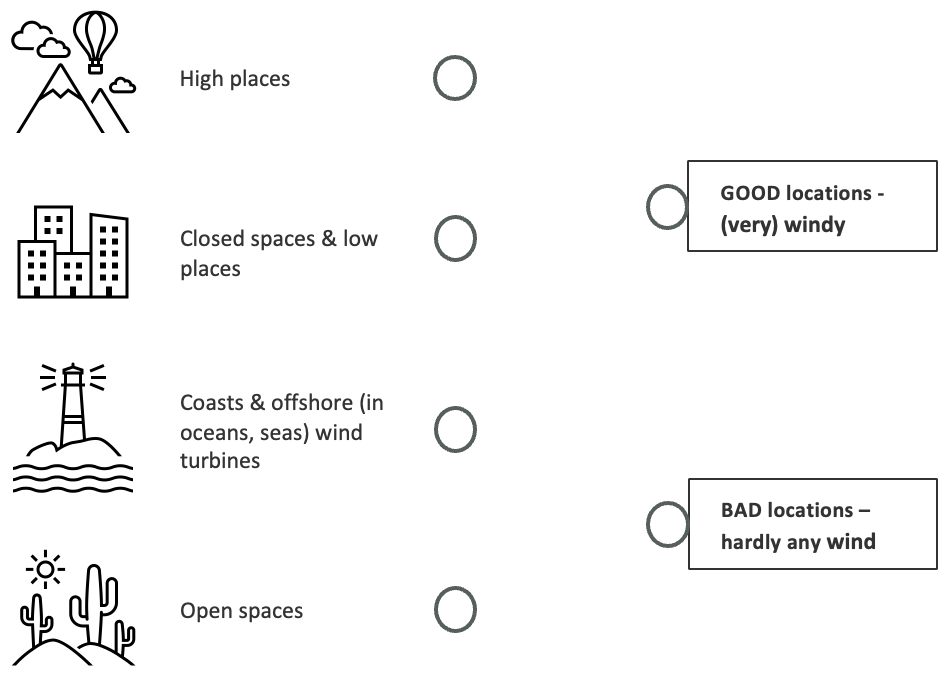
📝 Task 2
Explain why a certain area is good and what makes a certain area bad
In Summary
Windy places enable the generation of energy out of the movement of wind turbines.
Good places for wind energy production are where it is very windy.
↪ Examples: in high places, places with a lot of space, places next to the sea or ocean.
Bad places for wind energy production are where there is hardly any wind.
↪ Examples: in low places, in cities or locations with many obstacles.
1.3 The Wind Atlas
📝 Exercise: Task 1
- Split the class into groups of 4–5 students.
- Now visit the website down below (you can use the QR-Code).
- Select “Countries And Regions” on the left-hand side and compare Ghana and Germany.
- Check on the right-hand side that height is set to 100m.
- Now compare the two countries regarding their average power density (W/m²) and the speed of wind (m/s). What does that mean for the production of wind energy?
https://globalwindatlas.info/en/

What is your outcome? What does it mean for the quality of the country to generate wind energy?
1.4 Stakeholders in Wind Energy
In this chapter you will explore how different groups perceive the implementation of wind energy and how to consider all viewpoints.
📝 Exercise: Task 1 – Wind Energy Role Play
- Split the class into groups of 4–5 students.
- Each team represents a different stakeholder affected by a wind energy project in Ghana.
- Assign roles to each team member:
- Local Farmer: Concerned about losing land and the noise from turbines.
- Government Official: Promotes renewable energy for Ghana’s future.
- Engineer: Explains how wind turbines work and discusses technical challenges.
- Student: Curious about how wind energy will affect jobs, the environment and future opportunities.
- Environmentalist (optional): Advocates for clean energy to fight climate change.
- Scenario Setup: “A new wind farm is planned near a coastal village in Ghana. It will produce electricity for nearby towns but may also affect the local community and environment.”
- Now, look at the scenario and you assigned role and try to find arguments for your position. Write it down!
- Discussion: When everyone is ready, discuss your arguments and perspectives and present it to the class! Don`t be afraid, there is no right or wrong!

Chapter 2 – Measuring and working with wind
In this chapter, you will learn about:
- How wind speed is measured
- How wind does work
- Concepts of wind turbines
- Effects of wind conditions on energy generation
🎯 Learning Objective
At the end of this chapter, you will:
- Understand the importance of measuring wind speed and how it impacts energy generation.
- Build and use a basic anemometer to measure wind speed in various locations.
- Explore the concept of wind doing work through practical experiments.
- Analyze the effects of turbulence and storm conditions on wind energy generation.
- Gain insights into the role of gearboxes and how turbines convert wind into usable electricity.
2.1 Making a paper windrose
In this chapter you will play some games to learn about the basics of wind, energy and wind energy!
Activity:
Materials you will need for this activity:
- Printed Windrose Model
- Scissors
- Paper cup
- Tape
- Straw
Follow these steps to make your own wind rose:
- Cut out the square from the printed wind rose model
- Cut diagonally along the dotted lines until you reach the circle and then stop. Do not cut out the circle; leave it as it is.
- Place the corners in the center, one by one, as shown in the first and second picture.
- Take a straw and push it through the center of the compass rose, as shown in the third picture.
- Turn the paper cup upside down and attach the stick to the top of the cup using the adhesive tape, as shown in the fourth illustration.

2.2 Measuring Wind Speed
Experiment:
Material you will need for the experiment:
- Paper wind rose
- Stopwatch
- Colorful marker
Follow these steps to measure wind speed using the wind rose:
- Take your windrose and color each fan with a different colored marker.
- Place the paper windrose on a flat, stable surface where it can spin freely. You can do so by holding the windrose in your hand or by placing it on a stable support.
- Blow to move the windrose.
- Blow in low speed and count how many full rotations one cup completes in 1 minute. Use the stopwatch to measure time. Record this in an observation table like the one below.
- Repeat step 4 with different variation in wind speed while blowing and record it in the observation table.
Exercise:
Task 1
How does the speed of the wind relate to the number of rotations?
At what speed did the compass rose rotate the fastest and why is that?
In Summary
Anemometers are tools used to measure wind speed by counting rotations. Building an anemometer helps us understand how engineers measure wind to decide the best locations for wind turbines and other applications.
Wind speed is directly proportional to the number of rotations—the faster the wind, the more the windrose spins.
Wind speed varies across different locations and heights due to obstacles, turbulence, and environmental conditions.
Faster winds mean more energy potential, which is why open areas or high altitudes are ideal for wind energy projects.
2.3 Wind can do work
Experiment:
Material you will need for the experiment:
- Paper wind rose (built in the previous experiment)
- 30 cm light thread
- Tape
- Fan
- Stopwatch
- Paper clip
Follow these steps to conduct the experiment
Step 1: Tie one end of the thread to the end of the straw that binds the compass rose. Make a loop at the free end of the thread and attach a paper clip with adhesive tape to serve as a weight.
Step 2: Place the paper wind rose on a flat, stable surface on which it can rotate freely, e.g. on a table, as shown in the fourth illustration on page 22.
Step 3: Position a fan approximately 1 meter away from the windrose.
Step 4: Repeat step 4 at different speeds of fan and record it in the observation table.
Exercise:
Task 1:
How does the wind speed (low, medium, high) affect the speed of lifting weights with the wind rose?
Task 2:
How does the wind speed (low, medium, high) affect the speed of lifting weights with the wind rose?
Task 3:
How can this experiment relate to real wind turbines?
In Summary
Wind energy can perform mechanical work, as shown with the paper windrose lifting weights.
Higher wind speeds provide more energy, allowing heavier loads to be lifted.
As the load increases, more energy is needed and the windrose/anemometer/turbine may stop spinning if overloaded.
This demonstrates how wind turbines convert wind energy into useful power and highlights the importance of optimizing design and placement to maximize efficiency.
Test your knowledge on generators and gearboxes
Task 1
Fill in the Blanks
- A generator converts __________ (mechanical/thermal/chemical) energy into electrical energy.
- Wind turbines naturally spin __________ (quickly/slowly/moderately), but generators need a __________ (lower/higher/consistent) speed to produce electricity.
- The __________ (rotor/gearbox/stator) in a wind turbine increases the rotational speed of the shaft to match the generator’s requirements.
- The process of spinning a generator transforms __________ (kinetic/heat/light) energy into electricity.
- Gearboxes work by adjusting __________ and __________ (force & mass/speed & torque/direction & rotation) in the system.
Task 2
Write whether the given statements are true or false. Correct the statements if they are false.
- Wind turbines spin at a high speed naturally, making them directly compatible with generators.
- A generator uses electrical energy to create mechanical energy.
- The rotor is the stationary part of a generator.
- Gearboxes are used in wind turbines to adjust the rotational speed and torque.
- The energy conversion process in wind turbines involves transforming kinetic energy into mechanical energy and then into electrical energy.
Task 3
Match the terms in Column A to their corresponding definitions or functions in Column B.
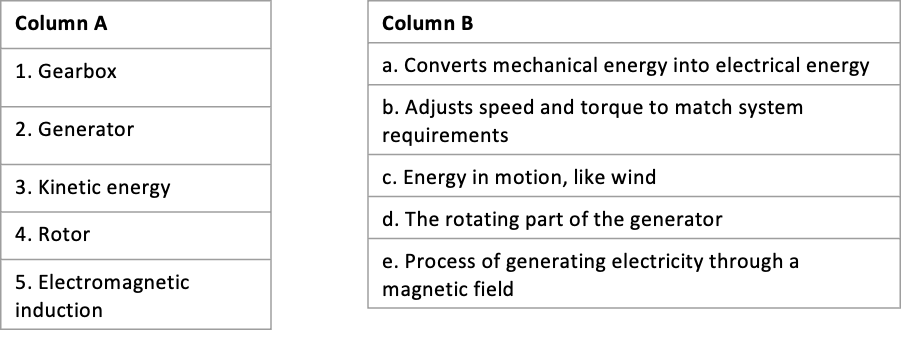
Chapter 3 – Airfoils
In this chapter, you will learn about:
- Building an airfoil
- The reasons for lift when the wind blows from the right direction
- Why a certain blade shape is so important
- What the Bernoulli principle is
- What factors influence the performance of wind turbines in general
🎯
Learning Objective
At the end of this chapter, you will:
- Understand the basics of airfoils and lift: Learn how the shape of blades (airfoils) creates lift by manipulating airflow and pressure differences.
- Explore the Bernoulli Principle in wind turbines: Understand how the Bernoulli principle, which helps airplanes fly, is applied in wind turbines to rotate the blades.
- Hands-on experiment with paper: See how a simple paper experiment demonstrates the principle of lift – blowing air over paper makes it rise due to pressure differences.
- Evaluate blade design for maximum efficiency: Recognize that the shape of a turbine blade (airfoil) is crucial for efficient wind energy generation.
- Consider factors influencing wind turbine performance: Analyze the external factors like wind speed, air density, and blade angle that impact the rotational speed and power output of wind turbines.
1. Let’s make an airfoil!
In this chapter, you will find out how to build an airfoil and how to experiment with it.
Materials you will need for this activity:
- Narrow wooden stick
- Adhesive tape
- 2x rectangular papers, size A5
- Hairdryer
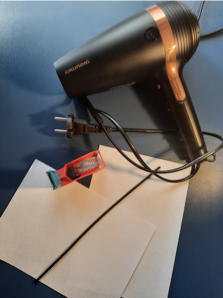
Follow these steps to conduct the experiment:
Place the two papers on top of each other such that they overlap properly.
Now stick the two sheets together with one adhesive tape on one of the two short sides so that they can be opened like a book.
Then lift the top sheet and stick it with another tape a little further into the center of the other sheet (approx. 3 fingers wide).
HINT: You can place an extra tape on the long side, rectangular to the tape you did in step 3, to make the hole flatter.
Check: You should have a curved paper on top and a flat paper on the bottom.
Now push the wooden stick through the hole and place it along the side that makes the larger bend.
Time for the experiment: Blow over the top surface, holding the wooden stick in both of your hands. You can either blow with your mouth or with a hairdryer.
For the steps one and two look at the following pictures:
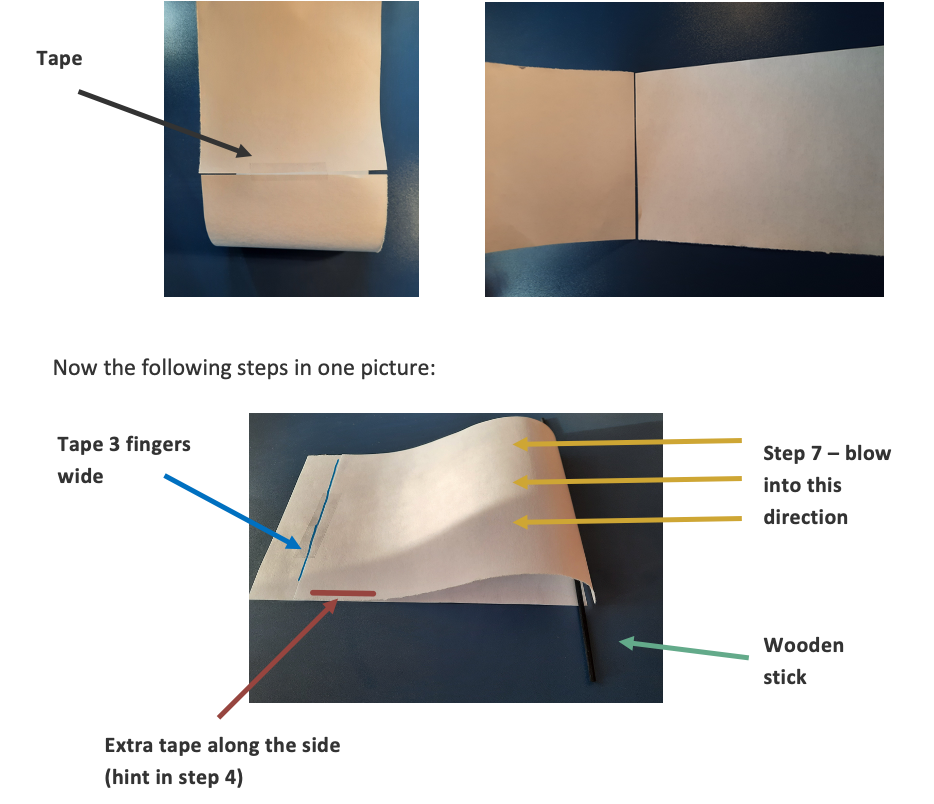
Exercise:
Task 1
What happens if you blow over the top surface, holding the wooden stick in both of your hands?
Task 2
What can be the reason for that observation?
Task 3
What should be the shape of the blades, referring to the observations so far?
Task 4
What factors could influence the output power of wind turbines?
In Summary
The experimentally constructed airfoils show how wind turbine blades are constructed and how they move when the wind blows.
Airfoils have a shape with a curved top and a flatter bottom to create a pressure difference when the air flows over them.
As the air moves faster over the top of the airfoil, there is a lower pressure at the top and a higher pressure at the bottom, which creates lift as the higher pressure pushes things upwards.
This airfoil is a model for wind energy wings and also for airplane wings!
Wind speed, blade size, blade shape, height, wind resistance and machine parts all influence the performance of wind turbines.
Chapter 4 – Experiments with a Wind Turbine
In this chapter, you will learn about:
- The wind turbine experiment kit
- Direction of the wind
- Angle of attack
- The task of a tail fin
- Different movement of the turbine in different wind directions
- What happens if you change the blade pitch
- What happens if you change the blade length
- How many blades must an ideal wind turbine have to generate the most energy
- What happens if you try a one-blade wind turbine
- Could you set an MPP (Maximum Power Point) at wind
🎯
Learning Objective
At the end of this chapter, you will:
- Understand the importance of wind direction: Learn how aligning a wind turbine to the wind direction increases performance and how the angle of attack affects efficiency.
- Explore the role of the tail fin: Discover how the tail fin helps the turbine to automatically align with the wind for maximum performance.
- Learn about blade pitch adjustment: Understand how changing the blade angle affects the cross-sectional area exposed to the wind and influences power generation.
- Evaluate the effects of blade length: See how longer blades can capture more wind and generate more power, but can also become too heavy, affecting performance.
- Analyze blade weight: Understand the consequences of blades that are too heavy and the importance of minimum wind speed for take-off.
- Compare the effects of blade count: Explore why three blades are often the optimal choice to balance performance and structural stability.
- Understand the limitations of single-blade designs: Learn how using only one blade results in unbalanced rotation and increased stress on the turbine structure.
- Introduction to the concept of maximum power point (MPP) in wind turbines: Briefly explore how turbine performance can be optimized by adjusting wind direction, blade pitch and design.
4.1 How to Measure the Power of Wind Turbines
To measure the power generated by the wind turbine, the experiments will use a multimeter. It is easy to handle and can measure electrical quantities like voltage, current, and resistance. For our experiments we stick to the unit of voltage to measure energy. Why that?
What is power?
Power is the amount of energy that something can produce or use in a certain amount of time. For wind turbines, power means the energy they create by turning wind into electricity.
How do we measure power?
Wind turbines generate electricity, and we need a way to measure how much power they produce. Normally, power is measured in units like watts (W). However, in some cases, we can use voltage to estimate power.
What is voltage?
Voltage is like the “pressure” in an electrical circuit. It tells us how strongly the electricity is being pushed through wires.
- Higher voltage means more electrical energy is moving.
- Lower voltage means less energy is being transferred.
Why is voltage a good proxy for power?
- Voltage and power are closely related in wind turbines.
- When the wind turbine produces more power, the voltage often increases.
- You can think of it like water flowing in a pipe: higher water pressure (voltage) means more water (power) flows.
In summary
Voltage is a helpful way to measure the power output of wind turbines because it directly reflects how much electrical energy is being produced at any moment.
4.2 How to Use a Multimeter
What is a multimeter?
A multimeter is a handy tool that can measure electrical quantities like voltage, current and resistance. Here’s a simple guide on how to use it, along with an explanation of its key parts and steps. For our experiments we stick to the unit of voltage to measure energy.
Parts of a multimeter
- Display: Shows the measurement results.
- Dial/Selector Switch: Used to select the quantity you want to measure (voltage, current, or resistance).
- Probes: Two wires with metal tips that you hold against the point you want to measure. The red probe is usually for positive connections, and the black probe is for negative connections.
- Ports: Sockets where you plug in the probes. There are usually three:
- COM: Common port, always for the black probe.
- VΩmA: For the red probe when measuring voltage, resistance, or small currents.
- 10A: For the red probe when measuring high currents.
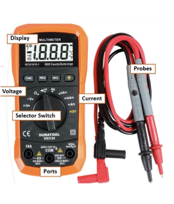
Important Steps to Use a Multimeter
- Turn on the multimeter: Make sure the multimeter is on by turning the dial.
- Select the measurement type:
- Voltage (V): To measure voltage, turn the dial to “V” with a straight line (for DC voltage) or a wavy line (for AC voltage).
- Just for complete information:
- Current (A): To measure current, turn the dial to “A” with the corresponding symbol. Choose between “mA” (milliamps) and “A” (amps) depending on the expected current — we usually just use mA!
- Resistance (Ω): To measure resistance, turn the dial to the “Ω” symbol.
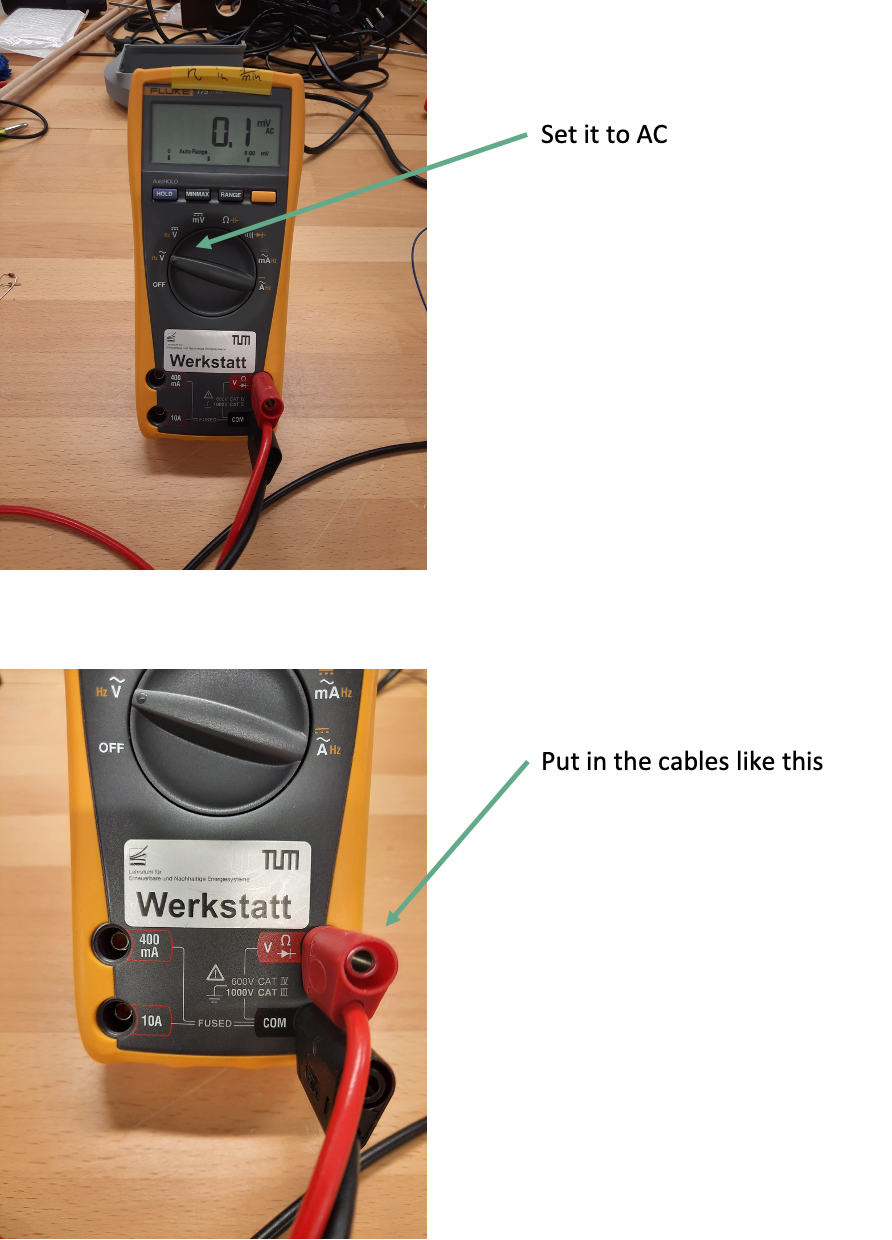
4.3 How to Use the Wind Turbine Kit
It’s time for you to gain hands-on experience with our wind turbine experiment kit! The kit replicates the basic functions of a real wind turbine and helps you to explore how it works and which factors influence its efficiency.
The picture below shows the different parts of the wind turbine and how to assemble it. Take a look before you start!
If you have any questions, don’t hesitate to ask your teacher for help.
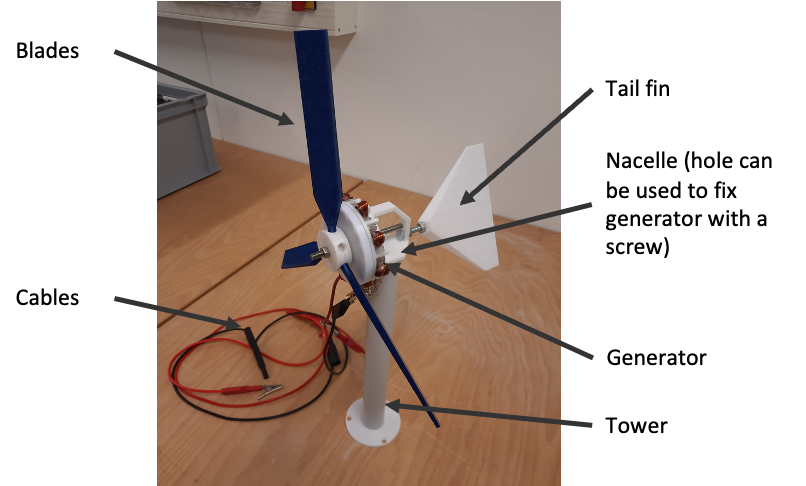
You can adjust the blade angles, as shown in the picture. For most experiments, we’ll use the blades in a flat position—unless stated otherwise.
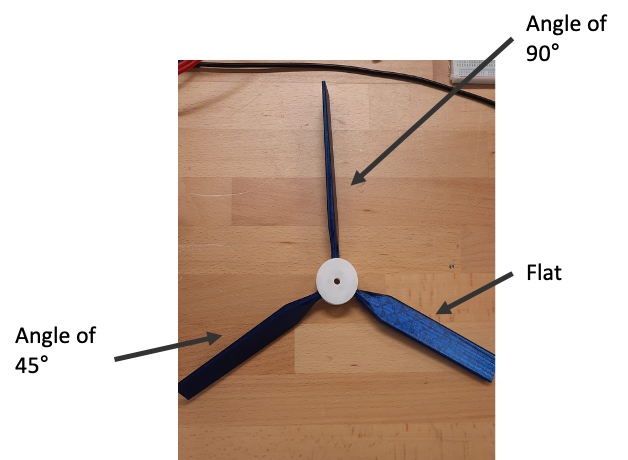
4.4 Changing Direction of Wind
📝 Exercise: Task 1
Look at the pictures below and draw the arrows of the wind direction so that the objects move as fast or as good as possible! What do they all have in common?
If you are finished, compare your answers in a group of 3–4 students.
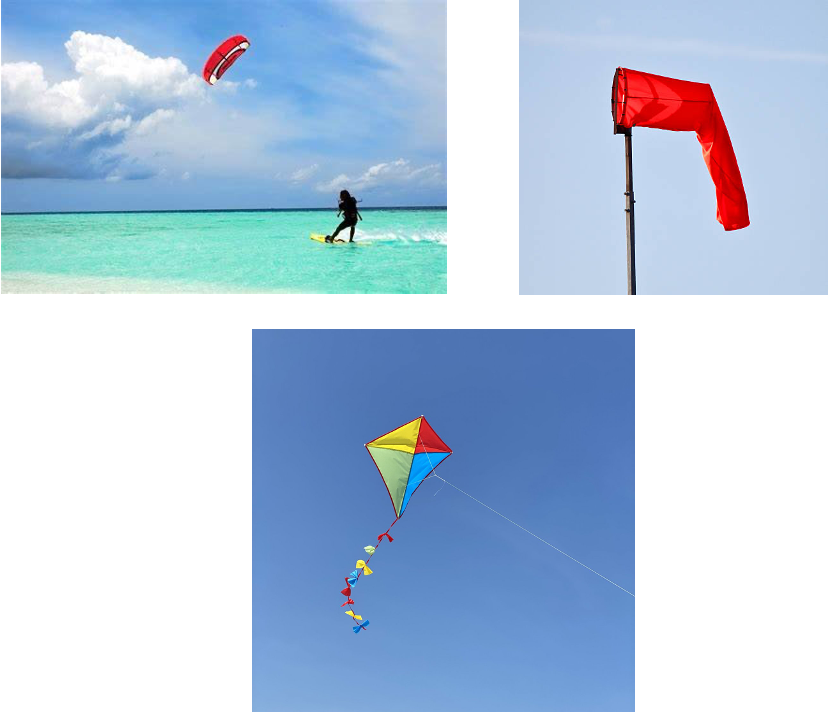
🧪 Experiment
Materials you will need for the experiment:
- Wind kit with 3 blades, medium size
- Fan
- Multimeter
Follow these steps to conduct the experiment:
Take your wind set and prepare it so that it contains three blades and place it in one position. Make sure that this position remains the same to ensure that the results are not affected by a different distance from the fan.
Place your wind set in front of the fan. Attach the nacelle with a screw (there are various holes you can use). The angle of the blades should be flat.
Now measure the voltage with the multimeter for low, medium and high speed with your fan for the following directions (maybe give a first push):
• Front view
• Turn it to the side (45°)
• Turn it to the side (90°)
Look at the pictures below to see what the directions mean and try the same with your wind kit.
Report your answers in the observation table on your worksheet.
Look at the pictures below to see what the different angles mean in execution.
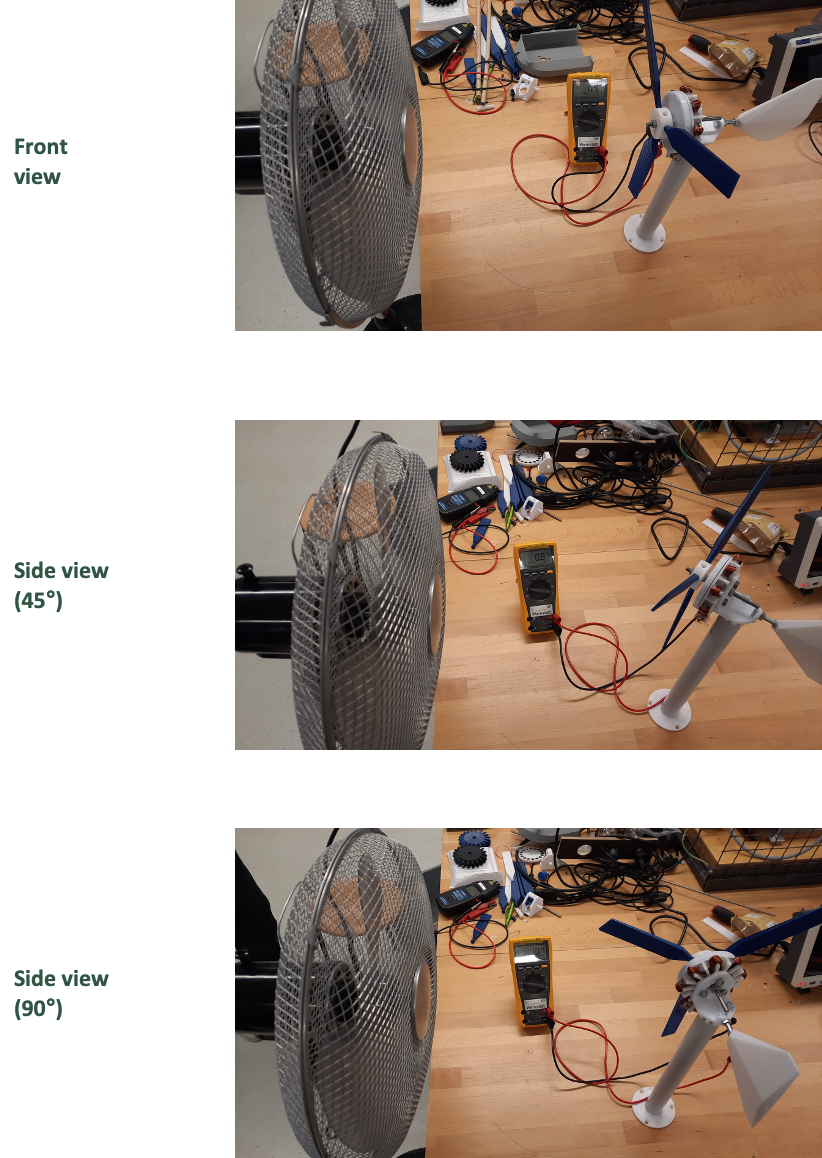
📝 Task 2
What did you observe? What does that mean?
4.5 Angle of Attack
📝 Task 1
Since we now know that the wind turbine must face directly into the wind and the wind changes throughout the day, the wind turbine must adjust its direction.
How can we align a wind turbine so that it faces directly into the wind?
- Look at the pictures below and think of a part that could be a solution.
- Talk to your neighbor and think about your ideas.
- Write your solution down.
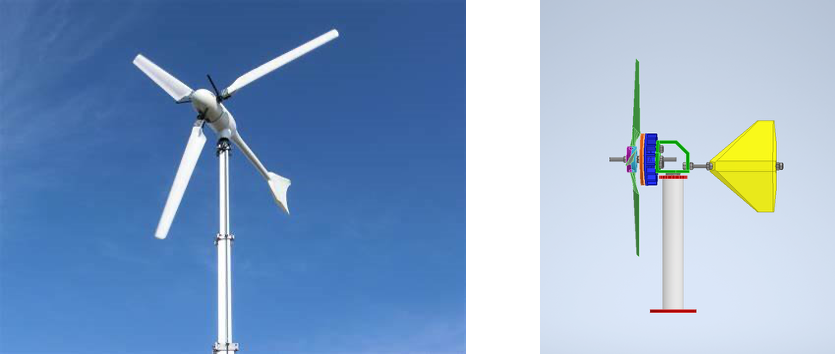
4.6 Using a Tail Fin
🧪 Experiment
Materials you will need for the experiment:
- Wind kit with 3 blades, medium size
- Fan
Follow these steps to conduct the experiment:
Take your wind set and prepare it so that it contains three blades and place it in one position. Make sure that this position remains the same to ensure that the results are not affected by a different distance from the fan.
Place your wind set in front of a fan. The angle of the blades should be flat. Do not fasten the nacelle with a screw!
Now measure the voltage with the multimeter for high speed with your fan for the following directions:
o Tail fin in work = vertical
o Tail fin not in work = horizontal
What did you observe? Write down your answers!
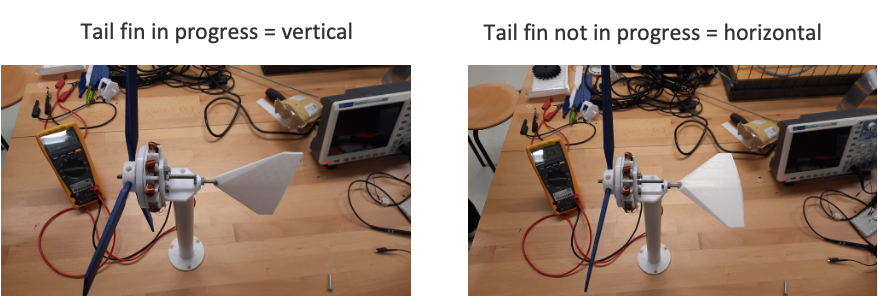
📝 Exercise
Task 1
Why do we need a functioning tail fin?
Task 2
Why do you think the turbine is able to move with the tail fin?
In Summary
The wind direction has an influence on the power generation of a wind turbine.
We have found that direct wind produces more power. Therefore, the angle of attack is an important concept to consider.
A functioning tail fin is required so that the turbine can face directly into the wind. This is because the turbine moves to reduce drag on the tail fin.
Therefore, a tail fin is essential for generating the maximum possible power.
🧠 Let’s Test Your Knowledge!
Task 1: What have we learned so far? Fill in the blanks and find out!
- The __________ (direct/side) wind has more power.
- To make the wind turbine face the wind, we attach a __________ (tail fin/rotor blade).
- The __________ (turbine/generator) spins to face the direct wind direction.
- The turbine moves to reduce __________ (power/drag) on the tail fin.
- The __________ (speed/angle) of attack affects how the turbine faces the wind.
- _______ (Direct/Side) wind has more power to move wind turbines.
- Wind turbines need _________ (less/more) wind to produce much energy.
Task 2: Are the following statements true or false?
- Direct wind has more power than side wind.
- The tail fin is attached to make the turbine face away from the wind.
- The turbine moves to reduce drag on the tail fin.
- Wind turbines do not need to face the wind to generate the most power.
- The tail fin helps the turbine align with the wind direction.
4.7 Changing Blade Pitch
🧪 Experiment
Materials you will need for the experiment:
- Wind kit with 3 blades, medium size
- Fan
- Multimeter
Follow these steps to conduct the experiment:
Take your wind set and prepare it so that it contains three blades and place it in one position. Make sure that this position remains the same to ensure that the results are not affected by a different distance from the fan.
Place your wind set in front of the fan. Attach the nacelle with a screw (there are various holes you can use). The angle of the blades is now different, see the pictures on the next slide.
Now measure the voltage with the multimeter for low, medium and high speed with your fan for the following angles (maybe give a first push):
• Angle of 90°
• Angle of 45°
• Flat
Report your answers in an observation table.
In Summary
Adjusting the angle of the blades influences how the wind moves them. The right angle ensures that the blades rotate faster and generate more energy.
How much energy the turbine can capture depends on how strongly the wind hits the blade. A flat-angled blade has the highest efficiency.
4.8 Changing Blade Length
🧪 Experiment
Materials you will need for the experiment:
- Wind kit with 3 blades
- Fan
- Multimeter
Follow these steps to conduct the experiment:
Take your wind set and prepare it so that it contains three blades and place it in one position. Make sure that this position remains the same to ensure that the results are not affected by a different distance from the fan.
Place your wind set in front of the fan. Attach the nacelle with a screw (there are various holes you can use). The angle of the blade should be flat.
Now measure the voltage with the multimeter for low, medium and high speed with your fan for the following blade lengths (maybe give a first push):
• short
• medium
• large
Short blades are visibly smaller and straight; medium ones are slightly longer with a minor bend; large blades are the longest with a wider surface. Refer to your wind kit parts for exact identification.
Report your answers in the observation table.
📝 Exercise: Task 1
What is your observation? How does the length of the blades affect the wind kit’s turning speed?
In Summary
Blade lengths affect directly how much wind is captured by the wind turbine.
4.9 Changing Number of Blades
🧪 Experiment
Materials you will need for the experiment:
- Wind kit with 2, 3, 6 blades (medium size)
- Fan
- Multimeter
Follow these steps to conduct the experiment:
Take your wind set and prepare it so that you have different blade lengths and place it in one position. Make sure that this position remains the same to ensure that the results are not affected by a different distance from the fan.
Place your wind kit in front of a fan. Attach the nacelle with a screw (there are various holes you can use). The angle of the blades should be flat.
Now measure the voltage with the multimeter for low, medium and high speed with your fan for the following blade numbers (maybe give a first push):
• Two blades
• Three blades
• Six blades
Look at the pictures below to see how it looks and try the same with your wind kit.
Report your answers in the observation table.

📝 Exercise
Task 1
What differences do you notice in voltage output between different blade configurations?
Task 2
What happens to the stability when the number of blades increases?
Task 3
What are the advantages and disadvantages of using turbines with more blades in real-world wind farms?
In Summary
The number of blades affects the efficiency of the turbine, the ease of starting and the voltage output.
Fewer blades may spin faster, but produce less consistent power and stability.
More blades provide greater stability and power generation, but can encounter resistance at high wind speeds.
Engineers optimize blade design to compensate for these trade-offs for specific wind farm conditions.
4.10 What happens with a wind turbine with only one blade?
🧪 Experiment
Materials you will need for this experiment:
- Wind kit with 1, 3 blades, long size
- Multimeter
- Fan
Follow these steps to conduct the experiment:
1
Take your wind set and prepare it so that you have attached a blade or three blades of “long” length, depending on what you want to start with. Make sure that this position remains the same to ensure that the results are not affected by varying distance from the fan.
2
Place your wind kit in front of a fan. Attach the nacelle with a screw (there are different holes you can use). The angle of the blades should be flat.
3
Now measure the voltage with the multimeter for high speed with your fan for the following blade numbers (maybe give a first push):
o One blade
o Three blades
4
Look at the pictures below to see how it looks and try the same with your wind kit.
5
Report your answers in an observation table.
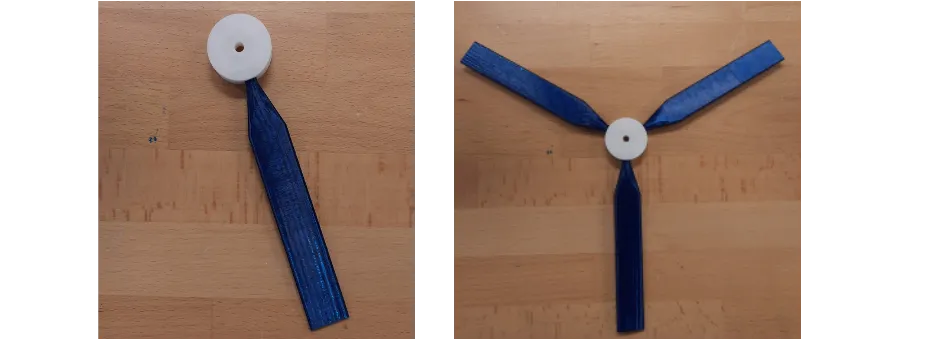
📝 Exercise
- Task 1: What did you observe?
- Task 2: Which blade number had a higher voltage at peak times?
- Task 3: What happens to the stability of the wind turbine in both cases?
- Task 4: What are possible explanations for your observation? And which system is better for wind energy generation in your opinion?
In Summary
With a wind turbine with only one blade, the turbine still moves, but it rotates completely differently.
The single-blade wind turbine moves unbalanced. The speed can change suddenly.
🧠 Let’s test your knowledge on Chapter 4!
Task 1 – Fill in the blanks
- The direction of wind has __________ (no/an) influence on the generation of wind.
- To make the wind turbine face the wind, we attach a __________ (tail fin/rotor blade).
- The pitch of the blade is optimal when it is ___________ (angled/flat).
- The _________ (shorter/longer) the blade is, the power production increases.
- If the blade is really heavy, the power will __________ (drop/increase).
- To generate the optimal power output with a wind turbine and have a balanced wind turbine system, the number of blades should be ________ (one/two/three/six).
- The turbine turns in an asymmetrical way if the number of blades is ________ (one/two/three/six).
Task 2 – Reflection
Write down at least three new things you have learned so far that you do not want to forget!
Task 3 – Fill in the blanks
- The Maximum Power Point (MPP) is the point where a wind turbine generates the _________ (lowest/highest/moderate) power output under given wind conditions.
- To optimize energy capture, the blade angle (pitch) should be ________ (adjusted/fixed/ignored) according to wind speed.
- Yaw control helps the turbine ________ (stay fixed/rotate towards/rotate away from) the wind direction for maximum efficiency.
- Wind turbines use ________ (sensors/batteries/magnets) to monitor wind speed and adjust for MPP in real time.
- Increasing rotor speed beyond MPP results in ________ (optimal performance/energy loss/increased efficiency).
Task 4 – True or False
Are the following statements true or false? Correct the statements if they are false.
- MPP ensures a wind turbine always operates at its maximum efficiency.
- Blade pitch control is unnecessary for maintaining MPP.
- Offshore wind farms use advanced control systems to optimize MPP in real-time.
- Wind turbines naturally adjust to MPP without any external systems.
- Dynamic wind conditions do not affect the Maximum Power Point.
Task 5 – Match the Terms
Match the terms in Column A to their corresponding definitions or functions in Column B.
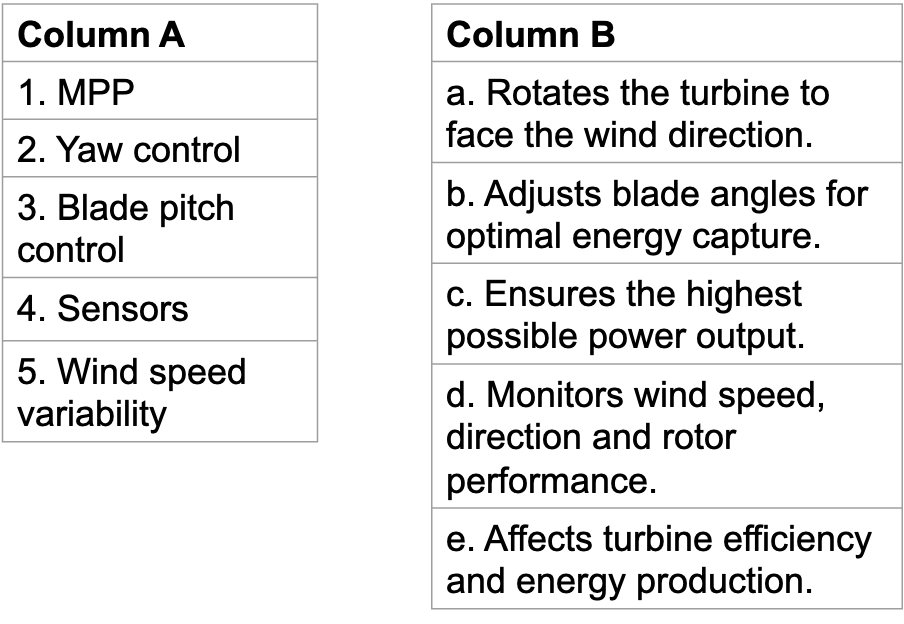
🎉 Playtime – Crossword Puzzle
Congratulations on completing this course on wind energy!
You’ve learned about how wind turbines work, the science behind wind power, and its role in renewable energy.
Now you can put your knowledge to the test with a fun wind energy crossword puzzle!
This puzzle challenges you with key terms related to wind energy—let’s see how many you can get right! Get ready to have fun and reinforce what you’ve learned.
